Abstract
Over the past decade, global cement production has exceeded 4 billion tonnes annually. This process has a considerable environmental impact and is estimated to account for approximately 5% to 7% of the total annual CO2 emissions released into the atmosphere. To mitigate the environmental consequences of cement production, extensive research has been conducted on alternative materials that can partially replace cement in concrete manufacturing, thereby reducing its carbon footprint. This study explores the utilisation of recycled brick powder as a supplementary cementitious material in mortar production, with replacement levels ranging from 5% to 45%. In addition to evaluating their mechanical properties, such as flexural and compressive strength, this research investigates the durability of the newly developed mortars. The results indicate a reduction in porosity of up to 50% and an enhancement in chloride penetration resistance by up to fourfold when the substitution rate is between 35% and 40% compared with mortar without replacement. Although no improvements were observed in carbonation resistance, the new mixtures exhibited an increase in resistivity of up to ninefold.
1. Introduction
Globally, concrete is the most widely used construction material [1,2]. Its widespread use is attributed to several advantages, including its favourable mechanical properties, adequate durability, abundant availability, low-cost raw materials, and versatility in design [3]. However, one of its primary drawbacks is the significant environmental impact associated with its production [4]. Recent studies indicate that the production of 1 m3 of concrete generates approximately 1 tonne of carbon dioxide (CO2), which is released into the atmosphere [5]. It is further estimated that the concrete industry is responsible for 8% of global CO2 emissions [6]. Of this amount, nearly 90% is generated during the cement manufacturing process [7,8,9]. This is primarily due to the chemical reactions that take place in the initial stages of production, particularly during the preheating phase (550 °C to 960 °C) of the powdered raw materials, when limestone (CaCO3) and magnesium carbonate (MgCO3) begin to decompose into calcium oxide (CaO), magnesium oxide (MgO), and carbon dioxide (CO2) [10]. In addition, the energy demands associated with the entire cement production process must be considered, as calcination requires temperatures exceeding 1200 °C [11]. Furthermore, the latest data indicate that the cement sub-sector accounts for approximately 12–15% of total industrial energy consumption [10].
Moreover, it is essential to consider the annual volume of cement produced and its projected consumption in the coming years. According to the European Cement Association (CEMBUREAU), global cement production in 1900 was merely 10 million tonnes. However, over the course of a century, this figure increased a hundredfold, surpassing 1.6 billion tonnes by 1998 [12]. Since then, production has continued to rise, reaching 4.1 billion tonnes in 2013—a level that has remained relatively stable up to 2023, according to CEMBUREAU [13,14]. Over the next 30 years, annual cement production is expected to reach 5 billion tonnes [15].
These figures underscore the crucial role of the cement industry in global development, as it is fundamental to the construction of key infrastructure and the advancement of nations [16]. However, despite both the recorded and projected growth in the coming years, the Cement Sustainability Initiative, in collaboration with the International Energy Agency, has set a target to reduce CO2 emissions from Portland cement production by 45% by 2050. This objective has driven, among other initiatives, a search for materials capable of partially replacing Ordinary Portland Cement (OPC) in concrete production—commonly referred to as supplementary cementitious materials (SCMs).
Among the most well-known SCMs are those derived as by-products of industrial processes. These materials have been extensively studied since the late 1990s, and include fly ash (FA), granulated blast furnace slag (GBFS), and silica fume (SF). When used in varying proportions, the partial replacement of OPC with these materials can enhance not only the mechanical properties of concrete but also its durability by improving characteristics such as porosity, permeability, and chloride diffusion resistance [17,18,19,20,21,22,23,24,25,26,27,28,29,30,31]. However, one of the main drawbacks of these SCMs is their limited availability, as well as their high economic cost compared to cement. While FA and GBFS are only slightly more expensive than OPC, the cost of SF can be between two and five times higher than that of OPC [32,33].
These limitations have driven researchers worldwide to investigate alternative SCMs, including agricultural wastes such as rice husk ash (RHA) and sugarcane bagasse ash (SBA). These by-products are distinguished by their high silica content, and when used as a partial replacement for OPC at levels ranging from approximately 20% to 30%, they can significantly improve concrete durability. However, their effect on mechanical properties remains relatively limited [34,35,36,37]. Within this subgroup of SCMs derived from agricultural wastes, wood waste ash and biomass fly ash can also be considered. These by-products, owing to their high pozzolanic content, can improve mechanical properties such as compressive and flexural strength when used as a partial replacement for OPC. However, their replacement levels are generally very low, typically not exceeding 5% [38]. Some researchers suggest that the replacement level can be increased to as much as 20% without significantly affecting the mechanical properties. However, the durability of the material may be compromised due to increased porosity or reduced resistance to chloride diffusion [38,39]. The primary drawback of this subgroup of SCMs is their limited availability, as they are confined to regions where these residues are generated, such as natural environments typically located far from industrial and urban centres. This geographical limitation poses challenges and hinders their widespread implementation.
However, among the materials generated in large cities, as well as in urban and industrial centres, construction and demolition waste (CDW) stands out as a potential SCM. According to various authors, CDW accounts for more than 30% of the total solid waste produced globally, a proportion that is expected to increase in the coming years [40]. In countries such as The Netherlands or Spain, bricks constitute more than 50% of CDW, offering significant potential for recycling and reuse in concrete production [41]. Their most widespread application is as a partial replacement for fine and coarse aggregates [42,43,44,45,46]. However, this approach does not contribute to reducing cement consumption. An alternative that can effectively lower cement consumption is the use of finely ground recycled brick powder (RBP) as an SCM [47]. Although this topic holds significant social and scientific interest, it has received limited attention in the literature to date. However, a few studies have begun to examine this scenario. Existing works have primarily focused on the mechanical properties of the material, yet their results reveal notable discrepancies. Most researchers report an improvement in mechanical properties when incorporating RBP as an SCM. For instance, Arif et al. observed that at a 10% replacement level, both compressive and flexural strength exhibited a slight increase (≈10%) [48]. Naceri and Hamina obtained similar results but observed that when the replacement percentage increased to 20%, both compressive and flexural strength experienced a decrease, which could reach up to 50% [49], similar data to those obtained by Mansoor et al. [50] and Ayaz-Khan et al. [51]. In contrast, Letelier et al. and Kirgiz, with OPC replacements of up to 30% and 35% using RBP, respectively, observed negligible variations in these properties, including in the modulus of elasticity, with result variability remaining below 5% [52,53]. On the other hand, Shao et al. explored replacement levels of up to 40% and identified 20% as the threshold for enhancing the material’s properties [54]. However, the same authors highlight that increasing the replacement percentage beyond 40% is counterproductive, as it results in a decline in the material’s compressive strength (from 54 MPa to 38 MPa) [54]. This trend was also observed by Wu et al. and Pitarch et al., who successfully replaced OPC with RBP at levels of up to 50% [55,56]. Conversely, other researchers, including Ge et al. [57] and Zhao et al. [20], reported a strength loss ranging from 20% to 30% at a 30% replacement level, similar to the data obtained by Amakye et al. [58], while Zou et al. documented a strength reduction exceeding 50% at a 40% replacement level. In contrast, Wu et al. indicated a compressive and flexural strength reduction lower than 30% at a 50% replacement level [59].
Despite these examples, relatively few studies have investigated the durability-related characteristics of concretes in which OPC has been partially replaced with RBP. Notably, in most cases, water-accessible porosity was the primary parameter assessed [60,61]. Mansoor et al. demonstrated that the incorporation of RBP can reduce the material’s porosity and identified 17% as the optimal substitution level [50]. Several authors have also reported reductions in water-accessible porosity, with decreases of 5% for a 10% substitution level [62], 25% for a 20% substitution level [56], and 8% for a 40% substitution level [63]. Studies that evaluated this property using MIP tests likewise recorded porosity reductions ranging from 7.8% to 21.7%, even at substitution levels of up to 30% [64]. Very few studies have focused on examining other properties, such as electrical resistivity or resistance to chloride penetration, and those that have done so report highly variable results [57,59,65,66,67]. These variations can be attributed to differences in the mixed proportions, substitution levels, and testing methodologies employed across studies. Conversely, other studies in the literature address broader case scenarios, where mixtures incorporating RBP and additives such as fly ash are investigated, or RBP is combined with other SCMs or powders (e.g., those derived from the grinding of concrete blocks or stones), making it challenging to establish a clear comparative framework [68,69,70,71,72,73]. In addition to the aforementioned factors, certain studies present particular cases in which recycled brick powder is used as a supplementary cementitious material (SCM), while simultaneously incorporating crushed brick as a partial replacement for both coarse and fine aggregates [74,75]. This dual substitution further complicates the interpretation and comparison of results across different investigations.
The limited number of studies focusing on the durability of mortars and concretes incorporating a partial replacement of OPC with RBP, combined with the uncertainty surrounding the data available in the literature, currently prevents this SCM from being utilised on a larger scale. Furthermore, the fact that many studies investigate RBP alongside other additions, such as FA or SF, or other waste materials used as SCMs, hinders the establishment of a clear comparative framework to distinctly identify the advantages or disadvantages of RBP.
This study was conceived in response to these limitations and aims to address the existing gap in the literature. The research presented includes an analysis of mortars in which up to 45% of OPC was replaced with RBP, with its results compared to those of a reference concrete made with 100% Portland cement. The tests conducted focused on evaluating various indirect durability-related properties, including the following: (a) porosity, as it directly affects the penetration of aggressive substances into the concrete; (b) chloride penetration resistance; (c) carbonation resistance, since both chloride penetration and carbonation contribute to reinforcement corrosion, one of the primary causes of deterioration in reinforced concrete structures; and (d) resistivity, which influences the material’s capacity to transport electric charges, a key factor in the ohmic control of reinforcement corrosion processes. Additionally, the effect of RBP incorporation on compressive strength was examined, and the pozzolanic reactivity of the RBP was also evaluated.
2. Experimental Plan
2.1. Materials
To produce the mortars analysed in this study, 0/4 silica sand and CEM I 42.5 R/SR cement (Lafarge) were used. The recycled brick powder (RBP) was obtained by grinding ceramic bricks. This process was carried out in three stages. Each brick (7 cm hollow red brick) was manually crushed into fragments smaller than 50 mm, which were subsequently ground in a ball mill (model Ibertest Micro-Deval AIB-1250) in two cycles of 55,000 revolutions, each lasting 480 min. The resulting material was sieved with a 1 mm sieve. It was then subjected to a third grinding cycle lasting 30 min using a smaller mill (Speedy Nannetti model). The obtained powder was sieved again, this time with a 0.5 mm sieve. The final sample was analysed via laser diffraction using a Mastersizer 3000 (model MAL1203757). The recycled brick powder (RBP) exhibited a particle size distribution similar to that of cement, with an average particle size of 6.5 μm, which is slightly smaller than that of cement (10.5 μm). The particle size distribution curves of RBP and OPC are presented in Figure 1. Furthermore, Table 1 and Figure 2 provide detailed information on the chemical composition and the findings derived from the X-ray diffraction (XRD) analysis of the recycled brick powder, respectively.
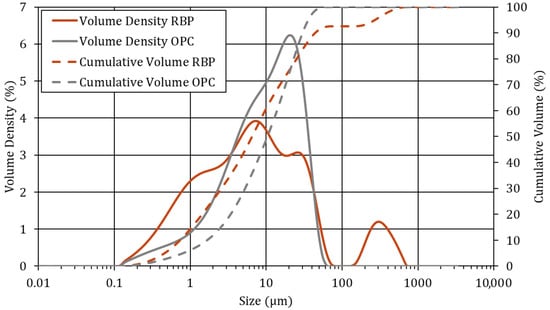
Figure 1.
Grading curves: RBP and OPC.

Table 1.
Chemical composition of RBP.
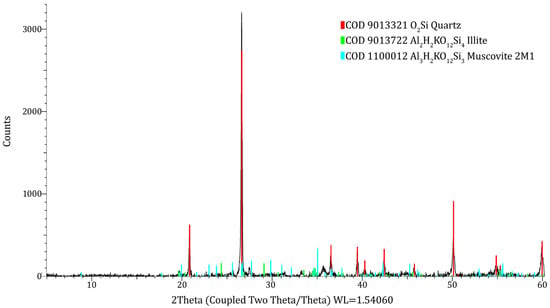
Figure 2.
X-ray diffraction pattern of RBP.
Table 2 presents the manufactured mixtures of the ten mortars produced using both the supplied cement and the RBP obtained through the grinding process. The nomenclature refers to the percentage of cement replaced with recycled brick powder. The reference mortar (C00) was prepared according to the mix proportions specified in the European standard UNE-EN 196-1:2008 for cement strength testing: one part cement, three parts standardised sand, and half a part water (1:3:0.5) [76]. In the remaining nine mix formulations, the cement was partially replaced with RBP in proportions ranging from 5% to 45%, while maintaining a constant water-to-cement ratio. To achieve a plastic consistency, a superplasticizer (Sika® ViscoCrete®—3425) was added to the reference mortar (C00). This admixture was also incorporated into the other mortars, with its dosage adjusted to maintain the same consistency. The reduced workability of mortars containing RBP was also reported by other authors [47,48,51] and is likely due to differences in shape and size between cement and RBP particles, as previously discussed. Table 2 also presents the fresh-state flowability results for each manufactured mortar, determined in accordance with the European standard UNE-EN 1015-3:2000 [77].

Table 2.
Manufactured mixtures (kg/m3).
Different test specimens were prepared with each of the previously described mortars to conduct this study. After casting, the specimens were kept in the moulds for the first 24 h, covered with plastic sheets for protection. They were then demoulded and stored in a curing chamber at 20 ± 2 °C and a relative humidity above 95% until they reached 90 days of age, at which point the tests described below were performed.
2.2. Methods
The compressive strength of each mortar was evaluated in accordance with European Standard UNE-EN 196-1:2008 [76]. The test was conducted on six 40 × 40 × 40 mm cubic specimens using an Ibertest MEH-1500SW testing machine. The loading rate was maintained at 2400 ± 200 N/s throughout the entire load application until failure. Additionally, flexural strength was assessed following the specifications of UNE-EN 196-1:2008 [76]. This test was performed on three 40 × 40 × 160 mm prismatic specimens using an Ibertest IBMU-4 testing machine, with the load applied at a testing speed of 50 ± 10 N/s until failure. In both cases, the reported results represent the average values obtained for each mixture.
To evaluate the durability of the manufactured mortars, four distinct tests were conducted: water-accessible porosity, carbonation resistance, chloride diffusion resistance, and resistivity. Additionally, to assess the effectiveness of RBP as an SCM, its pozzolanic reactivity was analysed by measuring the pH and electrical conductivity in lime–pozzolana solutions.
- Water-accessible porosity
Firstly, a study of water-accessible porosity was conducted on three cylindrical specimens (100 mm in diameter and 50 mm in height). The test was performed in accordance with the specifications of UNE 83980:2014 [78]. Prior to testing, the specimens were oven-dried at 105 °C until reaching a constant mass (Mdry). They were then vacuum-saturated with demineralised water. After 24 h under these conditions, the post-vacuum saturated mass (Msat) and hydrostatic mass (Mhyd) were determined for each specimen. The water-accessible porosity percentage (P) was calculated according to the formula specified in the test standard (Equation (1)). The result for each test and mix was taken as the arithmetic mean of the recorded values.
- Carbonation resistance
For each manufactured mortar, carbonation resistance was also assessed, as it is a key parameter in material durability, affecting the time to reinforcement depassivation. This test was performed in accordance with UNE 83993-2:2013 [79] on three prismatic test specimens (40 × 40 × 160 mm). During the test, the specimens were subjected to accelerated carbonation in a chamber with a 3.00 ± 0.6% CO2 concentration (chamber conditions: 20 ± 2 °C and 65 ± 5% RH). After 7 and 28 days of exposure, the specimens were removed from the chamber and subjected to a flexural test to split them and determine the penetration depth by applying a phenolphthalein indicator to the internal surfaces. The carbonation rate for each specimen (VCO2,3%) was calculated according to the formula specified in the test standard based on the penetration depth (x) and exposure time (t) in years (Equation (2)).
- Chloride diffusion resistance
Chloride diffusion into the concrete is a major cause of reinforcement corrosion and was therefore included as a key parameter in this study. Since this is a slow process, laboratory studies commonly employ accelerated methods, such as the one described in European Standard UNE-EN 12390-18:2021, which determines the chloride migration diffusion coefficient (Dnssm) [80]. This test was conducted on three cylindrical specimens (100 mm in diameter and 50 mm in height). The specimens were laterally sealed with epoxy paint and vacuum-saturated with calcium hydroxide before being placed in a test cell, ensuring that one exposed face was in contact with a 2-molar chloride solution, while the other face was in contact with a 0.3-molar sodium hydroxide solution. Chloride diffusion through the specimen was accelerated by applying a potential difference, with its value and duration defined by the standard based on an initial calibration measurement. At the end of the test, the specimens were split by indirect tensile failure, and their internal faces were sprayed with a 0.1 N silver nitrate solution. This colouration technique allowed for the determination of the chloride penetration depth (xd) in millimetres and the calculation of the chloride migration diffusion coefficient (Dnssm, ×10−12 m2/s) according to the equation specified in the test standard (Equation (3)) [80]. This equation also considers the applied voltage (U, in volts), the test duration (t, in hours), the average test temperature (T, in Celsius), and the specimen thickness (L, in mm). For all the mortar samples tested, cylindrical specimens with a thickness of 50 mm were employed. A constant potential difference of 30 V was applied throughout the test, which was conducted over a period of 24 h. The temperature in the testing room was maintained at a constant level of 23 ± 2 °C to ensure consistency in the test conditions. As previously mentioned, the average depth of chloride penetration for each specimen was determined at the end of the test using a colorimetric method with silver nitrate (0.1 N), which allowed for a clear visual demarcation of the chloride penetration depth.
- Electrical resistivity
Lastly, electrical resistivity was studied as it reflects the material’s ability to transport electric charges, which is crucial for the ohmic control of reinforcement corrosion processes, one of the primary causes of durability loss in reinforced concrete structures [81]. To determine this parameter, the procedure outlined in European Standard UNE-EN 12390-19:2023 was followed [82]. The test was conducted on three 40 × 40 × 160 mm prismatic specimens, which, at 90 days of age, were vacuum-saturated with demineralised water. After 24 h under these conditions, the specimens were removed from the solution and surface-dried. Using a conductivity metre (Crison GLP 32), the electrical conductivity of the material was measured, which is the inverse of its electrical resistance. The measurement was recorded for three minutes until a stable signal was achieved, and this final value was considered for each specimen. At the end of the test, each specimen was re-immersed to maintain saturation conditions, and weekly measurements were taken over one month to monitor the evolution of this property. The result of each test and mix was expressed as the arithmetic mean of the recorded values.
- Electrical conductivity and pH
One method for assessing the pozzolanic reactivity of recycled brick powder (RBP) is to measure the electrical conductivity and pH of lime–pozzolan aqueous suspensions over a seven-day period [83]. When lime is introduced into water, Ca(OH)2 dissociates into Ca2⁺ and OH− ions. The addition of a siliceous material to a saturated lime suspension can lead to system undersaturation. If the silica in RBP can react with the ions in the solution, insoluble reaction products will form and precipitate. Consequently, as the ion concentration decreases, the electrical conductivity will also decrease. Similarly, a reduction in OH− concentration will result in a lower pH. According to Tashima et al., system undersaturation occurs when the loss of conductivity exceeds 30% compared to a calcium hydroxide-saturated suspension, as well as when the pH reduction exceeds 0.15 units [83]. In this case, the material can be considered pozzolanically reactive.
To apply this method, a lime–RBP mass ratio of 2:8 was tested, with the total solid mass set at 2 g. Calcium hydroxide (95% purity), supplied by Scharlab (Barcelona, Spain), was used to prepare the calcium hydroxide suspension. First, a container was filled with 100 mL of deionised water and hermetically sealed to prevent water loss due to evaporation. It was then placed in a thermostatic cell until it reached the test temperature (60 °C), which was chosen to accelerate the reactions. Next, 0.4 g of calcium hydroxide was added, and the initial pH and conductivity readings were recorded. Subsequently, 1.6 g of RBP was introduced, and measurements were taken over a seven-day period. Throughout the test, the containers were maintained at a constant temperature of 60 °C ± 0.1 °C under an argon atmosphere to prevent carbonation. Similarly, the solution was kept under continuous stirring to facilitate pozzolanic reaction processes (Figure 3). Electrical conductivity and pH measurements were performed using a Crison GLP-32 conductivity metre and a Crison GLP-22 pH metre.
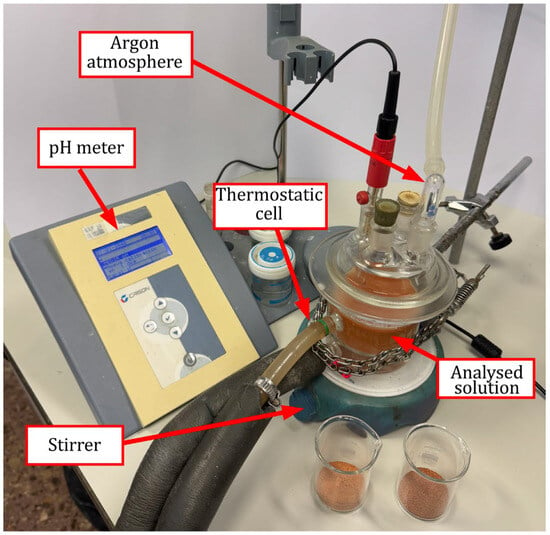
Figure 3.
Thermostatic cell for conductivity and pH tests in solutions.
To analyse the potential influence of particle size on the pozzolanic reactivity of the brick powder, electrical conductivity and pH measurements were also taken on a calcium hydroxide solution containing crushed brick, but with a larger particle size than the RBP used in the mortar production for this study (mass ratio 2:8). In this case, the particle size ranged between 100 and 250 μm, which is approximately 10 to 25 times larger than that of the RBP used in the mortars for this study.
3. Results
3.1. Compressive Strength
Figure 4 presents the average compressive strength of the specimens analysed for each manufactured mix.
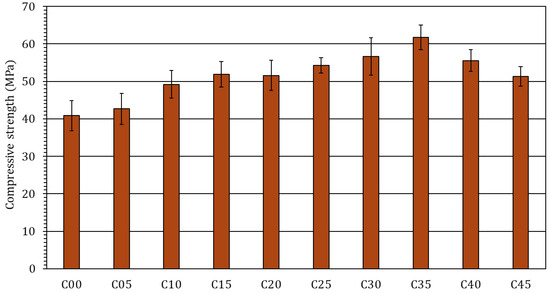
Figure 4.
Compressive strength.
As shown in Figure 3, the partial replacement of OPC with RBP has a notable impact on the compressive strength of the mortars. For replacement levels of up to 35%, strength progressively increases with the substitution percentage, reaching a 51% improvement in mortar C35 compared to the reference mortar C00 (61.7 MPa vs. 40.8 MPa, respectively). However, for higher replacement levels, this trend reverses, and compressive strength declines. Nevertheless, the strength of the mortar with 45% replacement (mix C45) remains 25% higher than that of C00 (51 MPa vs. 40.8 MPa, respectively).
The increase in compressive strength observed in mortars with partial cement replacement by RBP is attributed to the pozzolanic reaction of the brick powder. The pozzolanic reactivity of RBP was assessed by measuring the electrical conductivity and pH of calcium hydroxide/RBP aqueous suspensions. The results are presented in Figure 5 (brown line). The suspension, initially saturated with calcium hydroxide, showed a notable reduction in electrical conductivity within the first few hours of testing, decreasing by 60% after 7 days (168 h). According to Tashima et al. [83], when the conductivity loss is higher than 30%, it means that unsaturation of the suspension has been reached, which in turn indicates that a pozzolanic reaction has taken place. The silica in RBP reacts with ions in the solution, resulting in the formation of insoluble reaction products that precipitate. Consequently, as the ion concentration declines, electrical conductivity also decreases. Simultaneously, a notable change in pH values occurs due to the reaction of OH− groups (from calcium hydroxide) with RBP (Figure 5, right). After 7 days of testing, the pH decreased by 0.8 units, which is significantly greater than the 0.15-unit threshold proposed by Tashima et al. as an indicator of pozzolanic activity [83]. The significant decrease in pH recorded in the solution confirms the results obtained in the electrical conductivity loss test.
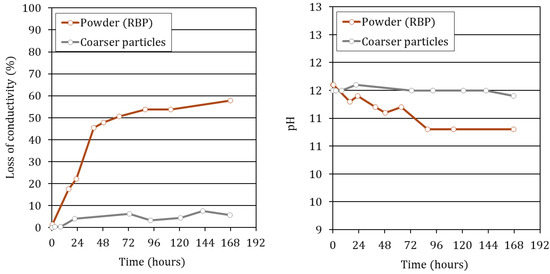
Figure 5.
Loss of electrical conductivity (left) and pH (right) values for suspensions made with recycled brick powder and coarser brick particles, tested during 7 days at 60 °C.
In summary, due to the pozzolanic nature of recycled brick powder (RBP), its high silica dioxide (SiO2) content reacts with the calcium hydroxide (Ca(OH)2) released during cement hydration, promoting the formation of C-S-H gels and, consequently, enhancing compressive strength. However, at higher cement replacement levels, the availability of Ca(OH)2 becomes limited, thereby restricting the pozzolanic reaction of RBP. Consequently, when cement replacement with RBP exceeds 35%, the increasing trend in compressive strength reverses and begins to decline (Figure 4).
Electrical conductivity and pH measurements were also taken in a calcium hydroxide solution containing crushed brick with a larger particle size, ranging from 100 to 250 μm (Figure 5, grey line). In this solution, no significant changes were observed in the electrical conductivity or pH after 7 days of testing. This suggests that coarser brick particles are considerably less reactive than finely ground ones, which may explain the substantial differences in mechanical performance reported by various authors in mortars and concretes incorporating partial cement replacement with RBP [83,84,85].
Figure 6 presents the average flexural strength of the specimens analysed for each manufactured mix. As observed, unlike the compressive strength study, no clear trend was identified. In all cases, the flexural strength ranged between 3.93 MPa and 4.83 MPa.
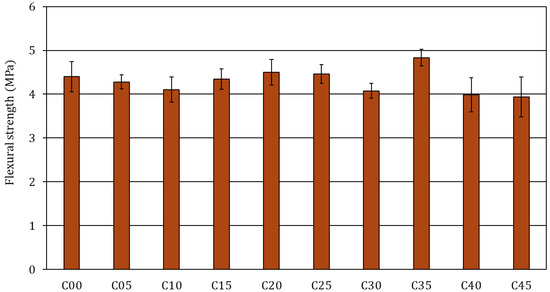
Figure 6.
Flexural strength.
3.2. Porosity Accessible to Water (Water Absorption)
The results obtained from the porosity accessible to water tests are shown in Figure 7. In this figure, the thresholds established by different authors for classifying the material’s durability are indicated [86,87].
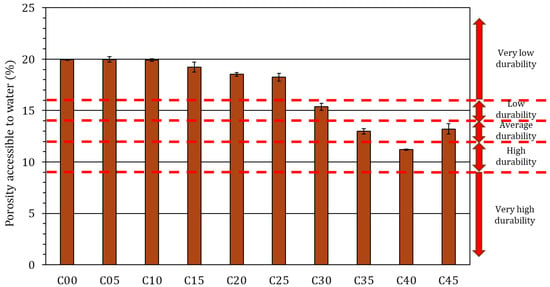
Figure 7.
Porosity accessible to water.
The results obtained exhibit a similar trend to that observed in the compressive strength tests. For cement replacements of up to 40%, porosity decreases as the replacement percentage increases, reaching a 43% reduction in mortar C40 compared to the reference mortar C00 (11.2% vs. 20% porosity, respectively). For higher replacement levels, the trend reverses, and porosity begins to increase. Nevertheless, even with a 45% replacement, the porosity of the mortar remains substantially lower than that of the reference mortar, showing a 34% reduction (13.2% vs. 20% porosity, respectively).
The reduction in porosity observed in mortars with partial cement replacement is attributed to the denser cementitious matrix produced by the pozzolanic reaction of RBP, as previously described. This reaction leads to the formation of C-S-H gel while also consuming part of the calcium hydroxide generated during cement hydration. The crystals of calcium hydroxide (portlandite) negatively impact porosity, as they act like microcracks, generating additional voids within the matrix [88]. In fact, according to [78], a refinement of the porous network takes place, decreasing the percentage of larger capillary pores and increasing the percentage of pores smaller than 100 nm. However, as with compressive strength, an excess of cement substitution limits the production of CaOH2 and therefore also the pozzolanic reaction of the RBP, which justifies that for cement substitutions higher than 40%, the porosity stops decreasing (Figure 7).
Water-accessible porosity is a key parameter closely related to concrete’s resistance to the ingress of aggressive agents and, therefore, serves as an indirect indicator of durability. In this regard, based on the thresholds established by some authors for classifying material durability [86,87], replacing 40% of cement with RBP improves durability, transforming a very low-durability mortar (mix C00) into a high-durability mortar. Even at 45% cement replacement (mix C45), the resulting mortars still fall within the average durability range (Figure 6).
3.3. Carbonation Resistance
Figure 8 shows images of various test specimens following a phenolphthalein staining of each analysed mixture. Figure 9 presents data on the carbonation depth in each mortar at 7 and 28 days. The reported values represent the arithmetic mean of the measurements taken on each face.
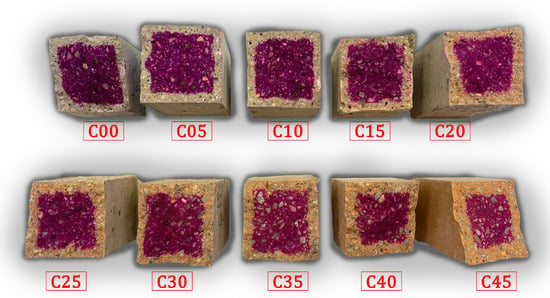
Figure 8.
Carbonation depth analysis (7 days).
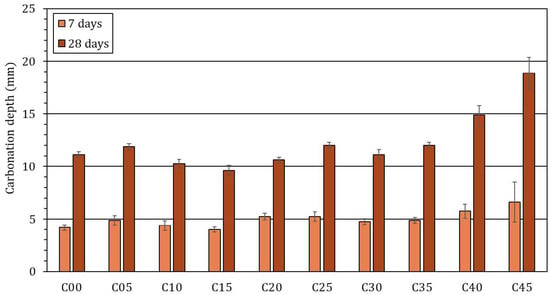
Figure 9.
Carbonation depth results.
As observed, the carbonation in the analysed samples exhibits highly variable results. Up to a substitution level of 35%, the carbonation depth remains practically similar across all samples compared to C00 at both 7 and 28 days (with variations of less than ±9%). However, samples C40 and C45 demonstrated lower resistance to carbonation, with penetration rates between 30% and 60% faster, reaching carbonation rates exceeding 40 mm/year1/2. Very few authors have investigated the carbonation resistance of mortars in which OPC is partially replaced by RBP. Researchers who have conducted similar experimental plans have reported findings consistent with those observed in this study. Both Schakow et al. and Zou et al. recorded comparable carbonation front penetration in reference samples and in mixes with up to 25% OPC replacements by RBP. However, at higher substitution levels (between 40% and 60%), they observed an increased carbonation rate [63,89].
As described in Section 3.2, increasing the proportion of RBP in the mixture leads to a reduction in the material’s pore network (noticeable when analysing porosity results or chloride diffusion data), thereby improving its resistance to carbonation. This reduction in porosity limits the ingress of carbon dioxide (CO2), which is a key factor in the carbonation process. However, at higher levels of substitution—specifically above 35%, as observed in this study—there is a pronounced tendency for the formation of a substantial amount of calcium silicate hydrate (C-S-H) gel because of the pozzolanic reaction. Additionally, a proportion of unreacted calcium silicates remains within the matrix, as discussed in Section 3.1 and corroborated by other studies [90]. In such cases, the increased presence of these reactive phases enhances their interaction with carbonic acid (H2CO3), which is generated when CO2 penetrates the material and reacts with pore water (H2O). This chemical environment consequently promotes a more rapid progression of carbonation, as supported by findings in the existing literature [91].
3.4. Chloride Diffusion Resistance
The results obtained from the chloride diffusion migration tests are presented in Figure 10. This figure also presents the thresholds established by other authors for classifying the material’s durability based on its resistance to chloride diffusion [86,87].

Figure 10.
Apparent chloride diffusion coefficient results measured by migration test.
The results obtained follow the trend observed in the previous tests. Using RBP as an SCM for OPC partial substitution reduced the apparent chloride diffusion coefficient. In this case, the optimal mixture was again the one with a 35% substitution, yielding an average value of 4.97 × 10−12 m2/s, which falls below the 5.00 × 10−12 m2/s threshold for classifying the material as highly durable. The value obtained for the C35 mix is four times lower than that of the reference mix (19.94 × 10−12 m2/s), indicating low durability. This trend in the results aligns with the observations from the accelerated carbonation study and is closely related to the accessible porosity data presented in Section 3.2. Ortega et al. reported a similar trend, noting a decrease of between 40% and 50% for substitution rates between 10% and 20% [92]. In contrast, Tremiño et al. also observed a significantly greater variation, but in tests conducted at 1500 days of age [62].
3.5. Electrical Resistivity
Resistivity is also an indirect indicator of durability. It gives information about pore connectivity and resistance to electric transfer, essential in electrochemical processes such as rebar corrosion [93]. The results obtained from resistivity monitoring are presented in the graphs in Figure 11. This figure also presents the thresholds established by other authors for classifying the material’s durability based on its electrical resistivity [86,87].
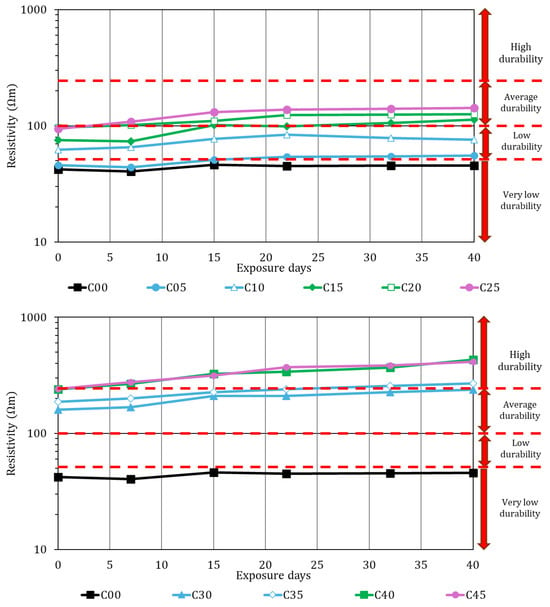
Figure 11.
Resistivity evolution.
The results exhibit a similar trend to those obtained in the previously described tests. The addition of RBP as a partial substitute for OPC significantly increased the resistivity of the mortar, reaching values eight and nine times higher than those of the reference mortar (C00) in mixes C45 and C40, respectively, indicating high durability [86,87]. The C30 and C35 mixes exhibited resistivities between four and five times higher than those of C00, while the C15, C20, and C25 mixes showed resistivities between two and three times higher than C00, reaching values typical of concrete with medium to high durability. In contrast, the C05 and C10 mixes showed little to no difference compared to the reference mortar (C00), indicating low or even very low durability [86,87].
As described in the analysis of RBP’s pozzolanic activity and according to Bertolini et al., the use of pozzolanic materials promotes the reaction of the pozzolan with calcium hydroxide in the presence of water. This reaction, which occurs after cement hydration, leads to the formation of C-S-H gels [94]. This secondary reaction generates more solid substances that block the capillary pore network, and this obstructs the flow of the electric current, producing a higher resistivity [95,96]. Furthermore, the filler effect densifies the matrix and accelerates hydration reactions, resulting in pore refinement and a more tortuous pore network [96]. Mortars and concretes including these characteristics have shown reduced permeability and higher chloride ion penetration resistance [97], which reduce the risk of the corrosion of the reinforcement, which is in accordance with the results described in Section 3.2 and 3.3.
4. Conclusions
In this study, the durability-related properties of eight different mortars in which Ordinary Portland Cement (OPC) was partially replaced with recycled brick powder (RBP) at substitution levels ranging from 5% to 45% were analysed. The results obtained led to the following conclusions:
- (1)
- RBP was identified as an effective supplementary cementitious material due to its pozzolanic reactivity, which was evaluated by measuring the electrical conductivity and pH of aqueous calcium hydroxide/RBP suspensions. When RBP partially replaces Ordinary Portland Cement (OPC), it reacts with the calcium hydroxide (Ca(OH)2) released during cement hydration, leading to the formation of C-S-H gels. This secondary reaction produces additional solid phases that obstruct the capillary pore network, resulting in pore refinement and a more tortuous microstructure.
- (2)
- The formation of additional C-S-H gels resulted in an increase in compressive strength when OPC was partially replaced with RBP. In mixtures where the substitution level was 35%, compressive strength increased by more than 50%. However, no significant effect on flexural strength was observed.
- (3)
- The partial replacement of OPC with RBP resulted in a reduction in water-accessible porosity, with a decrease of up to 43% observed at a substitution level of 40%.
- (4)
- Carbonation resistance remained virtually unaffected by the introduction of RBP at replacement levels of 35% or lower. However, at higher replacement levels, carbonation resistance decreased by 30% to 60%.
- (5)
- Chloride diffusion resistance improved with the partial replacement of OPC by RBP. In this case, at a substitution level of 35%, the chloride diffusion values were four times lower than those of the reference specimens.
- (6)
- The partial replacement of OPC with RBP also influenced the electrical resistivity of the material, increasing as the substitution level rose. At substitution levels of 40% and 45%, electrical resistivity increased by a factor of eight to nine, while at levels of 30% and 35%, the increase ranged from four to five times compared to the reference mixture (without RBP).
Based on the results obtained, a substitution level of 35% was identified as the optimum in this study. This substitution level not only resulted in the highest compressive strength but also led to notable improvements in durability-related properties, such as water-accessible porosity, resistance to chloride penetration, and electrical resistivity. Although higher substitution levels may still provide benefits compared to mixtures without any replacement, carbonation resistance can be significantly reduced, potentially affecting the long-term durability of the material.
Author Contributions
Conceptualisation, J.R.L.-F., A.A.-B. and M.V.; methodology, J.R.L.-F., A.A.-B. and M.V.; software, J.R.L.-F.; validation, J.R.L.-F., A.A.-B. and M.V.; formal analysis, J.R.L.-F., A.A.-B., P.M.-B. and M.V.; investigation, J.R.L.-F., A.A.-B., P.M.-B. and M.V.; resources, J.R.L.-F. and M.V.; data curation, J.R.L.-F., A.A.-B. and M.V.; writing—original draft preparation, J.R.L.-F., A.A.-B. and M.V.; writing—review and editing, J.R.L.-F., A.A.-B., P.M.-B. and M.V.; visualisation, J.R.L.-F., A.A.-B. and M.V.; supervision, P.M.-B. and M.V.; project administration, M.V.; funding acquisition, J.R.L.-F. and M.V. All authors have read and agreed to the published version of the manuscript.
Funding
This research was funded by the Universitat Politècnica de València, grant number PAID-06-24.
Institutional Review Board Statement
Not applicable.
Informed Consent Statement
Not applicable.
Data Availability Statement
The data presented in this study are available upon request from the corresponding author.
Acknowledgments
The authors would like to thank the Cátedra de Cambio Climático (Universitat Politècnica de València) and the Conselleria de Medio Ambiente, Infraestructuras y Territorio (Generalitat Valenciana) for the internship grant awarded to Alba Arenós Barrachina.
Conflicts of Interest
The authors declare no conflicts of interest.
References
- Zandifaez, P.; Nezhad, A.A.; Zhou, H.; Dias-da-Costa, D. A systematic review on energy-efficient concrete: Indicators, performance metrics, strategies, and future trends. Renew. Sustain. Energy Rev. 2024, 194, 114306. [Google Scholar] [CrossRef]
- EL Afandi, M.; Yehia, S.; Landolsi, T.; Qaddoumi, N.; Elchalakani, M. Concrete-to-concrete bond Strength: A review. Constr. Build. Mater. 2023, 363, 129820. [Google Scholar] [CrossRef]
- Mehta, P.K.; Monteiro, P.J.M. Concrete: Microstructure, Properties, and Materials, 4th ed.; McGraw-Hill Education: New York, NY, USA, 2014. [Google Scholar]
- Gursel, A.P.; Masanet, E.; Horvath, A.; Stadel, A. Life-cycle inventory analysis of concrete production: A critical review. Cem. Concr. Compos. 2014, 51, 38–48. [Google Scholar] [CrossRef]
- Kanagaraj, B.; Anand, N.; Raj, R.S.; Lubloy, E. Techno-socio-economic aspects of Portland cement, Geopolymer, and Limestone Calcined Clay Cement (LC3) composite systems: A-State-of-Art-Review. Constr. Build. Mater. 2023, 398, 132484. [Google Scholar] [CrossRef]
- Sinkhonde, D. Generating response surface models for optimisation of CO2 emission and properties of concrete modified with waste materials. Clean. Mater. 2022, 6, 100146. [Google Scholar] [CrossRef]
- Van Den Heede, P.; De Belie, N. Environmental impact; life cycle assessment (LCA) of traditional and “green” concretes: Literature review and theoretical calculations. Cem. Concr. Compos. 2012, 34, 431–442. [Google Scholar] [CrossRef]
- Chen, C.; Habert, G.; Bouzidi, Y.; Jullien, A. Environmental impact of cement production: Detail of the different processes and cement plant variability evaluation. J. Clean. Prod. 2010, 18, 478–485. [Google Scholar] [CrossRef]
- Hasanbeigi, A.; Menke, C.; Price, L. The CO2 abatement cost curve for the Thailand cement industry. J. Clean. Prod. 2010, 18, 1509–1518. [Google Scholar] [CrossRef]
- Benhelal, E.; Zahedi, G.; Shamsaei, E.; Bahadori, A. Global strategies and potentials to curb CO2 emissions in cement industry. J. Clean. Prod. 2013, 51, 142–161. [Google Scholar] [CrossRef]
- Kääntee, U.; Zevenhoven, R.; Backman, R.; Hupa, M. Cement manufacturing using alternative fuels and the advantages of process modelling. Fuel Process. Technol. 2004, 85, 293–301. [Google Scholar] [CrossRef]
- Aïtcin, P.C. Cements of yesterday and today—Concrete of tomorrow. Cem. Concr. Res. 2000, 30, 1349–1359. [Google Scholar] [CrossRef]
- The European Cement Association (CEMBUREAU). The European Cement Association: Activity Report, Brussels, Belgium, 2023. Available online: https://www.cembureau.eu/media/dnbf4xzc/activity-report-2023-for-web.pdf (accessed on 12 December 2024).
- Shen, W.; Cao, L.; Li, Q.; Zhang, W.; Wang, G.; Li, C. Quantifying CO2 emissions from China’s cement industry. Renew. Sustain. Energy Rev. 2015, 50, 1004–1012. [Google Scholar] [CrossRef]
- Schneider, M.; Romer, M.; Tschudin, M.; Bolio, H. Sustainable cement production-present and future. Cem. Concr. Res. 2011, 41, 642–650. [Google Scholar] [CrossRef]
- Rodrigues, F.A.; Joekes, I. Cement industry: Sustainability, challenges and perspectives. Environ. Chem. Lett. 2011, 9, 151–166. [Google Scholar] [CrossRef]
- Onyenokporo, N. Supplementary Cementitious Materials as Sustainable Partial Replacement for Cement in the Building Industry. Int. J. Archit. Environ. Eng. 2021, 15, 407–417. [Google Scholar]
- Yao, Z.T.; Ji, X.S.; Sarker, P.K.; Tang, J.H.; Ge, L.Q.; Xia, M.S.; Xi, Y.Q. A comprehensive review on the applications of coal fly ash. Earth-Sci. Rev. 2015, 141, 105–121. [Google Scholar] [CrossRef]
- Khedr, S.A.; Abou-Zeid, M.N. Characteristics of Silica-Fume Concrete. J. Mater. Civ. Eng. 1995, 6, 357–375. [Google Scholar] [CrossRef]
- Zhao, H.; Sun, W.; Wu, X.; Gao, B. The properties of the self-compacting concrete with fly ash and ground granulated blast furnace slag mineral admixtures. J. Clean. Prod. 2015, 95, 66–74. [Google Scholar] [CrossRef]
- Shekarchi, M.; Rafiee, A.; Layssi, H. Long-term chloride diffusion in silica fume concrete in harsh marine climates. Cem. Concr. Compos. 2009, 31, 769–775. [Google Scholar] [CrossRef]
- Song, H.W.; Pack, S.W.; Nam, S.H.; Jang, J.C.; Saraswathy, V. Estimation of the permeability of silica fume cement concrete. Constr. Build. Mater. 2010, 24, 315–321. [Google Scholar] [CrossRef]
- Bhanja, S.; Sengupta, B. Influence of silica fume on the tensile strength of concrete. Cem. Concr. Res. 2005, 35, 743–747. [Google Scholar] [CrossRef]
- Giergiczny, Z. Fly ash and slag. Cem. Concr. Res. 2019, 124, 105826. [Google Scholar] [CrossRef]
- Beycioglu, A.; Aruntaş, H.Y. Workability and mechanical properties of self-compacting concretes containing LLFA, GBFS and MC. Constr. Build. Mater. 2014, 73, 626–635. [Google Scholar] [CrossRef]
- Yang, X.; Wu, S.; Xu, S.; Chen, B.; Chen, D.; Wang, F.; Jiang, J.; Fan, L.; Tu, L. Effects of GBFS content and curing methods on the working performance and microstructure of ternary geopolymers based on high-content steel slag. Constr. Build. Mater. 2024, 410, 134128. [Google Scholar] [CrossRef]
- Oner, A.; Akyuz, S. An experimental study on optimum usage of GGBS for the compressive strength of concrete. Cem. Concr. Compos. 2007, 29, 505–514. [Google Scholar] [CrossRef]
- Saranya, P.; Nagarajan, P.; Shashikala, A.P. Eco-friendly GGBS Concrete: A State-of-The-Art Review. IOP Conf. Ser. Mater. Sci. Eng. 2018, 330, 012057. [Google Scholar] [CrossRef]
- Ahmad, J.; Kontoleon, K.J.; Majdi, A.; Naqash, M.T.; Deifalla, A.F.; Kahla, N.B.; Isleem, H.F.; Qaidi, S.M.A. A Comprehensive Review on the Ground Granulated Blast Furnace Slag (GGBS) in Concrete Production. Sustainability 2022, 14, 8783. [Google Scholar] [CrossRef]
- Gesoǧlu, M.; Güneyisi, E.; Özbay, E. Properties of self-compacting concretes made with binary, ternary, and quaternary cementitious blends of fly ash, blast furnace slag, and silica fume. Constr. Build. Mater. 2009, 23, 1847–1854. [Google Scholar] [CrossRef]
- Özbay, E.; Erdemir, M.; Durmuş, H.I. Utilization and efficiency of ground granulated blast furnace slag on concrete—A review. Constr. Build. Mater. 2016, 105, 423–434. [Google Scholar] [CrossRef]
- Van Tuan, N.; Ye, G.; Van Breugel, K.; Fraaij, A.L.A.; Bui, D.D. The study of using rice husk ash to produce ultra high performance concrete. Constr. Build. Mater. 2011, 25, 2030–2035. [Google Scholar] [CrossRef]
- Rahla, K.M.; Mateus, R.; Bragança, L. Comparative sustainability assessment of binary blended concretes using Supplementary Cementitious Materials (SCMs) and Ordinary Portland Cement (OPC). J. Clean. Prod. 2019, 220, 445–459. [Google Scholar] [CrossRef]
- Saraswathy, V.; Song, H.W. Corrosion performance of rice husk ash blended concrete. Constr. Build. Mater. 2007, 21, 1779–1784. [Google Scholar] [CrossRef]
- Chao-Lung, H.; Le Anh-Tuan, B.; Chun-Tsun, C. Effect of rice husk ash on the strength and durability characteristics of concrete. Constr. Build. Mater. 2011, 25, 3768–3772. [Google Scholar] [CrossRef]
- Thomas, B.S.; Yang, J.; Bahurudeen, A.; Abdalla, J.A.; Hawileh, R.A.; Hamada, H.M.; Nazar, S.; Jittin, V.; Ashish, D.K. Sugarcane bagasse ash as supplementary cementitious material in concrete—A review. Mater. Today Sustain. 2021, 15, 100086. [Google Scholar] [CrossRef]
- Neto, J.d.S.A.; de França, M.J.S.; de Amorim Júnior, N.S.; Ribeiro, D.V. Effects of adding sugarcane bagasse ash on the properties and durability of concrete. Constr. Build. Mater. 2021, 266, 120959. [Google Scholar] [CrossRef]
- Rajamma, R.; Ball, R.J.; Tarelho, L.A.C.; Allen, G.C.; Labrincha, J.A.; Ferreira, V.M. Characterisation and use of biomass fly ash in cement-based materials. J. Hazard. Mater. 2009, 172, 1049–1060. [Google Scholar] [CrossRef]
- Chowdhury, S.; Mishra, M.; Suganya, O. The incorporation of wood waste ash as a partial cement replacement material for making structural grade concrete: An overview. Ain Shams Eng. J. 2015, 6, 429–437. [Google Scholar] [CrossRef]
- Ginga, C.P.; Ongpeng, J.M.C.; Daly, M.K.M. Circular economy on construction and demolition waste. Materials 2020, 13, 2970. [Google Scholar] [CrossRef]
- de Andrade Salgado, F.; de Andrade Silva, F. Recycled aggregates from construction and demolition waste towards an application on structural concrete: A review. J. Build. Eng. 2022, 52, 104452. [Google Scholar] [CrossRef]
- Khalaf, F.M. Using Crushed Clay Brick as Coarse Aggregate in Concrete. J. Mater. Civ. Eng. 2006, 18, 518–526. [Google Scholar] [CrossRef]
- Xu, L.; Su, W.; Su, T. Influence of recycled clay brick aggregate on the mechanical properties of concrete. Rev. Adv. Mater. Sci. 2022, 61, 372–380. [Google Scholar] [CrossRef]
- Zhang, S.; He, P.; Niu, L. Mechanical properties and permeability of fiber-reinforced concrete with recycled aggregate made from waste clay brick. J. Clean. Prod. 2020, 268, 121690. [Google Scholar] [CrossRef]
- Yang, J.; Du, Q.; Bao, Y. Concrete with recycled concrete aggregate and crushed clay bricks. Constr. Build. Mater. 2011, 25, 1935–1945. [Google Scholar] [CrossRef]
- Zheng, C.; Lou, C.; Du, G.; Li, X.; Liu, Z.; Li, L. Mechanical properties of recycled concrete with demolished waste concrete aggregate and clay brick aggregate. Results Phys. 2018, 9, 1317–1322. [Google Scholar] [CrossRef]
- Tang, Q.; Ma, Z.; Wu, H.; Wang, W. The utilization of eco-friendly recycled powder from concrete and brick waste in new concrete: A critical review. Cem. Concr. Compos. 2020, 114, 103807. [Google Scholar] [CrossRef]
- Arif, R.; Khitab, A.; Kırgız, M.S.; Khan, R.B.N.; Tayyab, S.; Khan, R.A.; Anwar, W.; Arshad, M.T. Experimental analysis on partial replacement of cement with brick powder in concrete. Case Stud. Constr. Mater. 2021, 15, e00749. [Google Scholar] [CrossRef]
- Naceri, A.; Hamina, M.C. Use of waste brick as a partial replacement of cement in mortar. Waste Manag. 2009, 29, 2378–2384. [Google Scholar] [CrossRef]
- Mansoor, S.S.; Hama, S.M.; Hamdullah, D.N. Effectiveness of replacing cement partially with waste brick powder in mortar. J. King Saud Univ. Eng. Sci. 2022, 36, 524–532. [Google Scholar] [CrossRef]
- Khan, M.N.A.; Liaqat, N.; Ahmed, I.; Basit, A.; Umar, M.; Khan, M.A. Effect of Brick Dust on Strength and Workability of Concrete. IOP Conf. Ser. Mater. Sci. Eng. 2018, 414, 012005. [Google Scholar] [CrossRef]
- Letelier, V.; Ortega, J.M.; Muñoz, P.; Tarela, E.; Moriconi, G. Influence of Waste brick powder in the mechanical properties of recycled aggregate concrete. Sustainability 2018, 10, 1037. [Google Scholar] [CrossRef]
- Kirgiz, M.S. Strength gain mechanisms of blended-cements containing marble powder and brick powder. KSCE J. Civ. Eng. 2015, 19, 165–172. [Google Scholar] [CrossRef]
- Shao, J.; Gao, J.; Zhao, Y.; Chen, X. Study on the pozzolanic reaction of clay brick powder in blended cement pastes. Constr. Build. Mater. 2019, 213, 209–215. [Google Scholar] [CrossRef]
- Pitarch, A.M.; Reig, L.; Tomás, A.E.; Forcada, G.; Soriano, L.; Borrachero, M.V.; Payá, J.; Monzó, J.M. Pozzolanic activity of tiles, bricks and ceramic sanitary-ware in eco-friendly Portland blended cements. J. Clean. Prod. 2021, 279, 123713. [Google Scholar] [CrossRef]
- Wu, J.D.; Guo, L.P.; Qin, Y.Y. Preparation and characterization of ultra-high-strength and ultra-high-ductility cementitious composites incorporating waste clay brick powder. J. Clean. Prod. 2021, 312, 127813. [Google Scholar] [CrossRef]
- Ge, Z.; Gao, Z.; Sun, R.; Zheng, L. Mix design of concrete with recycled clay-brick-powder using the orthogonal design method. Constr. Build. Mater. 2012, 31, 289–293. [Google Scholar] [CrossRef]
- Amakye, S.Y.; Abbey, S.J.; Olubanwo, A.O. Consistency and mechanical properties of sustainable concrete blended with brick dust waste cementitious materials. SN Appl. Sci. 2021, 3, 420. [Google Scholar] [CrossRef]
- Wu, H.; Xiao, J.; Liang, C.; Ma, Z. Properties of cementitious materials with recycled aggregate and powder both from clay brick waste. Buildings 2021, 11, 119. [Google Scholar] [CrossRef]
- Horsakulthai, V. Effect of recycled concrete powder on strength, electrical resistivity, and water absorption of self-compacting mortars. Case Stud. Constr. Mater. 2021, 15, e00725. [Google Scholar] [CrossRef]
- Sun, C.; Chen, L.; Xiao, J.; Singh, A.; Zeng, J. Compound utilization of construction and industrial waste as cementitious recycled powder in mortar. Resour. Conserv. Recycl. 2021, 170, 105561. [Google Scholar] [CrossRef]
- Tremiño, R.M.; Real-Herraiz, T.; Letelier, V.; Ortega, J.M. Four-years influence of waste brick powder addition in the pore structure and several durability-related parameters of cement-based mortars. Constr. Build. Mater. 2021, 306, 124839. [Google Scholar] [CrossRef]
- Schackow, A.; Stringari, D.; Senff, L.; Correia, S.L.; Segadães, A.M. Influence of fired clay brick waste additions on the durability of mortars. Cem. Concr. Compos. 2015, 62, 82–89. [Google Scholar] [CrossRef]
- Zhao, Y.; Gao, J.; Liu, C.; Chen, X.; Xu, Z. The particle-size effect of waste clay brick powder on its pozzolanic activity and properties of blended cement. J. Clean. Prod. 2020, 242, 118521. [Google Scholar] [CrossRef]
- Chen, X.; Zhang, D.; Cheng, S.; Xu, X.; Zhao, C.; Wang, X.; Wu, Q.; Bai, X. Sustainable reuse of ceramic waste powder as a supplementary cementitious material in recycled aggregate concrete: Mechanical properties, durability and microstructure assessment. J. Build. Eng. 2022, 52, 104418. [Google Scholar] [CrossRef]
- Gonçalves, J.P.; Tavares, L.M.; Filho, R.D.T.; Fairbairn, E.M.R. Performance evaluation of cement mortars modified with metakaolin or ground brick. Constr. Build. Mater. 2009, 23, 1971–1979. [Google Scholar] [CrossRef]
- Filho, R.D.T.; Gonçalves, J.P.; Americano, B.B.; Fairbairn, E.M.R. Potential for use of crushed waste calcined-clay brick as a supplementary cementitious material in Brazil. Cem. Concr. Res. 2007, 37, 1357–1365. [Google Scholar] [CrossRef]
- Liu, Q.; Tong, T.; Liu, S.; Yang, D.; Yu, Q. Investigation of using hybrid recycled powder from demolished concrete solids and clay bricks as a pozzolanic supplement for cement. Constr. Build. Mater. 2014, 73, 754–763. [Google Scholar] [CrossRef]
- Liu, Q.; Li, B.; Xiao, J.; Singh, A. Utilization potential of aerated concrete block powder and clay brick powder from C&D waste. Constr. Build. Mater. 2020, 238, 117721. [Google Scholar] [CrossRef]
- Rao, M.C. Influence of brick dust, stone dust, and recycled fine aggregate on properties of natural and recycled aggregate concrete. Struct. Concr. 2021, 22, E105–E120. [Google Scholar] [CrossRef]
- Duan, Z.; Hou, S.; Xiao, J.; Li, B. Study on the essential properties of recycled powders from construction and demolition waste. J. Clean. Prod. 2020, 253, 119865. [Google Scholar] [CrossRef]
- Liu, X.; Liu, E.; Fu, Y. Reduction in Drying Shrinkage and Efflorescence of Recycled Brick and Concrete Fine Powder–Slag-Based Geopolymer. Appl. Sci. 2023, 13, 2997. [Google Scholar] [CrossRef]
- Yuan, C.; Fu, W.; Raza, A.; Li, H. Study on Mechanical Properties and Mechanism of Recycled Brick Powder UHPC. Buildings 2022, 12, 1622. [Google Scholar] [CrossRef]
- Zhou, Y.; Wang, R. Application of the supplementary cementitious material and aggregates made from waste clay bricks in the preparation of plastering mortar. Constr. Build. Mater. 2024, 450, 138705. [Google Scholar] [CrossRef]
- Letelier, V.; Tarela, E.; Moriconi, G. Mechanical Properties of Concretes with Recycled Aggregates and Waste Brick Powder as Cement Replacement. Procedia Eng. 2017, 171, 627–632. [Google Scholar] [CrossRef]
- UNE-EN:2018; Métodos de Ensayo de Cementos. Parte 1. Determinación de Resistencias. AENOR: Madrid, Spain, 2018; pp. 1–4.
- UNE-EN 1015-3:2000; Métodos de Ensayo de Los Morteros Para Albañilería. Parte 3. Determinación de la Consistencia del Mortero Fresco (Por la Mesa de Sacudidas). AENOR: Madrid, Spain, 2000.
- UNE 83980:2014; Durabilidad del Hormigón. Métodos de Ensayo. Determinación de la Absorción de Agua, la Densidad y la Porosidad Accesible al Agua del Hormigón. AENOR: Madrid, Spain, 2024.
- UNE 83993-2:2013; Durabilidad del Hormigón. Métodos de Ensayo. Determinación de la Velocidad de Penetración de la Carbonatación en el Hormigón Endurecido. Parte 2. Método Acelerado. AENOR: Madrid, Spain, 2024.
- UNE-EN 12390-18:2021; Ensayos de Hormigón Endurecido. Parte 18. Determinación del Coeficiente de Migración de Cloruros. AENOR: Madrid, Spain, 2021.
- Lliso-Ferrando, J.R.; Gasch, I.; Martínez-Ibernón, A.; Valcuende, M. Macrocell Corrosion Currents in Simulated Concrete Pore Solution and Reinforced Concrete. Int. J. Concr. Struct. Mater. 2023, 17, 15. [Google Scholar] [CrossRef]
- UNE-EN 12390-19:2023; Ensayos de Hormigón Endurecido. Parte 19. Determinación de la Resistividad Eléctrica. AENOR: Madrid, Spain, 2024.
- Tashima, M.M.; Soriano, L.; Monzó, J.; Borrachero, M.V.; Akasaki, J.L.; Payá, J. New method to assess the pozzolanic reactivity of mineral admixtures by means of pH and electrical conductivity measurements in lime: Pozzolan suspensions. Mater. Constr. 2014, 64, 316. [Google Scholar] [CrossRef]
- Zhang, H.; Zhang, C.; He, B.; Yi, S.; Tang, L. Recycling fine powder collected from construction and demolition wastes as partial alternatives to cement: A comprehensive analysis on effects, mechanism, cost and CO2 emission. J. Build. Eng. 2023, 71, 106507. [Google Scholar] [CrossRef]
- Li, S.; Chen, G.; Zhao, Y.; Xu, Z.; Luo, X.; Liu, C.; Gao, J. Investigation on the reactivity of recycled brick powder. Cem. Concr. Compos. 2023, 139, 105042. [Google Scholar] [CrossRef]
- Wang, W.; Liu, J.; Agostini, F.; Davy, C.A.; Skoczylas, F.; Corvez, D. Durability of an Ultra High Performance Fiber Reinforced Concrete (UHPFRC) under progressive aging. Cem. Concr. Res. 2014, 55, 1–13. [Google Scholar] [CrossRef]
- Baroghel-Bouny, V. Conception des Bétons Pour une Durée de vie Donnée des Ouvrages—Maîtrise de la Durabilité vis-à-vis de la Corrosion des Armatures et de L’alcali-Réaction—Etat de L’art et Guide Pour la Mise en Oeuvre d’une Approche Performantielle et Prédictive sur la Bas, Bagneux, France, 2004. Available online: http://eprints.uanl.mx/5481/1/1020149995.PDF (accessed on 10 December 2024).
- Vernet, C. Mécanismes Chimiques d’Interactions Ciment-Adjuvants; Centre Technique Groupe, Spa: Guerville, France, 1995. [Google Scholar]
- Zou, Z.; Provoost, S.; Gruyaert, E. Utilization of Waste Brick Powder as a Partial Replacement of Portland Cement in Mortars. Sustainability 2024, 16, 624. [Google Scholar] [CrossRef]
- Chen, G.; Li, S.; Zhao, Y.; Xu, Z.; Luo, X.; Gao, J. Hydration and microstructure evolution of a novel low-carbon concrete containing recycled clay brick powder and ground granulated blast furnace slag. Constr. Build. Mater. 2023, 386, 131596. [Google Scholar] [CrossRef]
- Chinchón-Payá, S.; Andrade, C.; Chinchón, S. Indicator of carbonation front in concrete as substitute to phenolphthalein. Cem. Concr. Res. 2016, 82, 87–91. [Google Scholar] [CrossRef]
- Ortega, J.M.; Letelier, V.; Solas, C.; Moriconi, G.; Climent, M.Á.; Sánchez, I. Long-term effects of waste brick powder addition in the microstructure and service properties of mortars. Constr. Build. Mater. 2018, 182, 691–702. [Google Scholar] [CrossRef]
- Sengul, O. Use of electrical resistivity as an indicator for durability. Constr. Build. Mater. 2014, 73, 434–441. [Google Scholar] [CrossRef]
- Bertolini, L.; Elsener, B.; Pedeferri, P.; Redaelli, E.; Polder, R.B. Corrosion of Stell in Concrete: Prevention, Diagnosis and Repair; Wiley-VCH: Weinheim, Germany, 2013. [Google Scholar]
- Likes, L.; Markandeya, A.; Haider, M.M.; Bollinger, D.; McCloy, J.S.; Nassiri, S. Recycled concrete and brick powders as supplements to Portland cement for more sustainable concrete. J. Clean. Prod. 2022, 364, 132651. [Google Scholar] [CrossRef]
- Rios, R.T.; Lolli, F.; Xie, L.; Xie, Y.; Kurtis, K.E. Screening candidate supplementary cementitious materials under standard and accelerated curing through time-series surface resistivity measurements and change-point detection. Cem. Concr. Res. 2021, 148, 106538. [Google Scholar] [CrossRef]
- Polder, R.B.; Peelen, W.H.A. Characterisation of chloride transport and reinforcement corrosion in concrete under cyclic wetting and drying by electrical resistivity. Cem. Concr. Compos. 2002, 24, 427–435. [Google Scholar] [CrossRef]
Disclaimer/Publisher’s Note: The statements, opinions and data contained in all publications are solely those of the individual author(s) and contributor(s) and not of MDPI and/or the editor(s). MDPI and/or the editor(s) disclaim responsibility for any injury to people or property resulting from any ideas, methods, instructions or products referred to in the content. |
© 2025 by the authors. Licensee MDPI, Basel, Switzerland. This article is an open access article distributed under the terms and conditions of the Creative Commons Attribution (CC BY) license (https://creativecommons.org/licenses/by/4.0/).